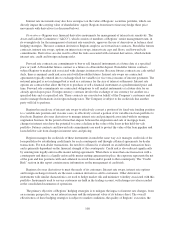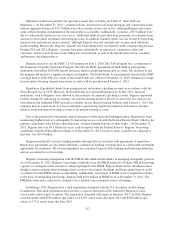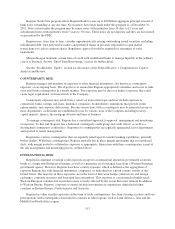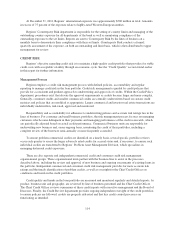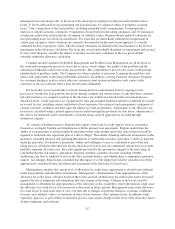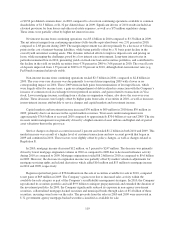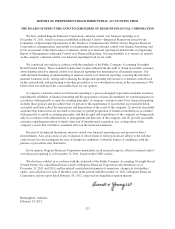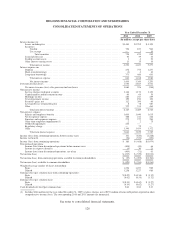Regions Bank 2011 Annual Report Download - page 142
Download and view the complete annual report
Please find page 142 of the 2011 Regions Bank annual report below. You can navigate through the pages in the report by either clicking on the pages listed below, or by using the keyword search tool below to find specific information within the annual report.Details regarding the allowance for credit losses, including an analysis of activity from the previous year’s
total, are included in Table 17 “Allowance for Credit Losses.” Also, refer to Table 18 “Allocation of the
Allowance for Loan Losses” for details pertaining to management’s allocation of the allowance for loan losses to
each loan category.
FINANCIAL DISCLOSURE AND INTERNAL CONTROLS
Regions has always maintained internal controls over financial reporting, which generally include those
controls relating to the preparation of the consolidated financial statements in conformity with accounting
principles generally accepted in the U.S. Regions’ process for evaluating internal controls over financial
reporting starts with understanding the risks facing each of its functions and areas, how those risks are controlled
or mitigated, and how management monitors those controls to ensure that they are in place and effective. These
risks, control procedures and monitoring tools are documented in a standard format. This format not only
documents the internal control structures over all significant accounts, but also places responsibility on
management for establishing feedback mechanisms to ensure that controls are effective. These monitoring
procedures are also part of management’s testing of internal controls. At least quarterly, each area updates and
assesses the adequacy of its documented internal controls. If changes are necessary, updates are made more
frequently.
Regions has also established processes to ensure appropriate disclosure controls and procedures are
maintained. These controls and procedures as defined by the Securities and Exchange Commission (“SEC”) are
generally designed to ensure that financial and non-financial information required to be disclosed in reports filed
with the SEC is reported within the time periods specified in the SEC’s rules and forms, and that such
information is communicated to management, including the Chief Executive Officer (“CEO”) and Chief
Financial Officer (“CFO”), as appropriate, to allow timely decisions regarding required disclosure.
Regions’ Disclosure Review Committee, which includes representatives from the legal, risk management,
accounting, investor relations, treasury and audit departments, meets quarterly to review recent internal and
external events to determine whether all appropriate disclosures have been made in reports filed with the SEC. In
addition, the CEO and CFO meet quarterly with the SEC Filings Review Committee, which includes senior
representatives from accounting, legal, risk management, audit, treasury, human resources, and operations and
technology. The SEC Filings Review Committee reviews certain reports to be filed with the SEC, including
Forms 10-K and 10-Q and evaluates the adequacy and accuracy of the disclosures. As part of this process,
certifications of internal control effectiveness are obtained from accounting, treasury, legal, audit, risk
management, human resources, administration, and operations and technology. These certifications are reviewed
and presented to the CEO and CFO as support of the Company’s assessment of internal controls over financial
reporting. The Forms 10-K and 10-Q are presented to the Audit Committee of the Board of Directors for
approval. Financial results and other financial information are also reviewed with the Audit Committee on a
quarterly basis.
As required by applicable regulatory pronouncements, the CEO and the CFO review and make various
certifications regarding the accuracy of Regions’ periodic public reports filed with the SEC, as well as the
effectiveness of disclosure controls and procedures and internal controls over financial reporting. With the
assistance of the financial review committees noted in the previous paragraph, Regions will continue to assess
and monitor disclosure controls and procedures and internal controls over financial reporting, and will make
refinements as necessary.
COMPARISON OF 2010 WITH 2009—CONTINUING OPERATIONS
Regions reported a net loss available to common shareholders of $763 million, or $0.62 per diluted common
share, in 2010 compared to a net loss available to common shareholders of $1.3 billion, or $1.27 per diluted
share, in 2009. Regions reported a loss from continuing operations available to common shareholders of $692
million,
118


